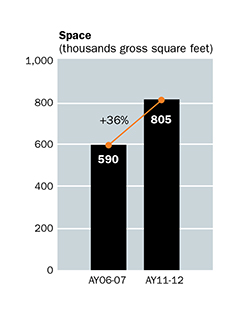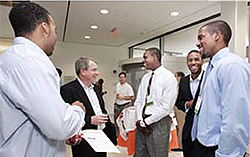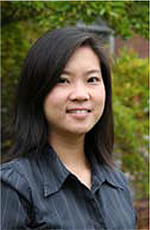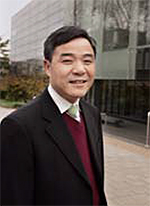Aspire campaign helps engineers address critical societal needs
By
on

 Princeton University’s Aspire fundraising campaign concluded June 30, 2012, having raised $327 million to support “Engineering and a Sustainable Society.” The gifts established major new centers for teaching and research, 10 professorships, two preceptorships, more than 175,000 square feet of new construction and more than $60 million for innovative research.
Princeton University’s Aspire fundraising campaign concluded June 30, 2012, having raised $327 million to support “Engineering and a Sustainable Society.” The gifts established major new centers for teaching and research, 10 professorships, two preceptorships, more than 175,000 square feet of new construction and more than $60 million for innovative research.
“The tremendous generosity of our alumni and friends already is accelerating work that will provide clean energy, protect the environment, improve health, and secure information and infrastructure around the world,” said H. Vincent Poor, dean of engineering. “Through the Aspire campaign, we are doing more than ever to prepare all Princeton students to be leaders and to make wise use of technology. I join my colleagues in saying a heartfelt thank you to all who participated.”
Several important outcomes of the Aspire campaign include the Andlinger Center for Energy and the Environment, the Keller Center for Innovation in Engineering Education, Sherrerd Hall and more than $60 million-worth of innovation funds to support transformative research. These key areas of growth are outlined below. For more information visit www.princeton.edu/aspire.

Keller Center
The first gift to Aspire came from Dennis (Class of 1963) and Constance Keller, endowing a bold initiative to broaden the education of engineers and to engage students from all parts of the University in a deeper understanding of technology. The Keller Center for Innovation in Engineering Education now supports many courses, extracurricular programs, internships and events that foster entrepreneurship, service and hands-on projects. One of the center’s latest initiatives, called eLab, allowed four teams of students to spend 10 weeks on campus last summer building businesses they created.
 “One of the beautiful things about eLab was that there were so many fields represented and everyone was pursuing their dream of building a business,” said Malik Jackson, a junior majoring in politics. Jackson and fellow students worked on MyGZpoints, a company that rewards students for performing well in school. The interactions with other eLab teams and the many guest speakers provided a crash course in marketing plans, presentation skills and business development, Jackson said. “These concepts were outside my comprehension prior to elab.”
“One of the beautiful things about eLab was that there were so many fields represented and everyone was pursuing their dream of building a business,” said Malik Jackson, a junior majoring in politics. Jackson and fellow students worked on MyGZpoints, a company that rewards students for performing well in school. The interactions with other eLab teams and the many guest speakers provided a crash course in marketing plans, presentation skills and business development, Jackson said. “These concepts were outside my comprehension prior to elab.”
Andlinger Center
In 2008, international businessman Gerhard Andlinger ’52 endowed the Andlinger Center for Energy and the Environment, which supports interdisciplinary efforts to develop sustainable sources of energy and comprehensive environmental solutions. In addition to a major new laboratory, faculty positions and an active program of guest speakers and corporate affiliations, Aspire campaign gifts have created a variety of funds to support innovative research and student projects.
 “What motivates me in my work is the bigger context of the research, namely the world’s current energy challenges,” said Josephine Elia, a graduate student who received the Andlinger Center’s Maeder Graduate Fellowship. Elia works with Professor Christodoulos Floudas to design chemical and energy processes and strategic planning approaches for providing U.S. transportation fuels from non-petroleum sources. “The Maeder Graduate Fellowship is essential in enabling the work and progress of this research. It underscores the Andlinger Center’s commitment to bridging academic contributions to real-world implementation.”
“What motivates me in my work is the bigger context of the research, namely the world’s current energy challenges,” said Josephine Elia, a graduate student who received the Andlinger Center’s Maeder Graduate Fellowship. Elia works with Professor Christodoulos Floudas to design chemical and energy processes and strategic planning approaches for providing U.S. transportation fuels from non-petroleum sources. “The Maeder Graduate Fellowship is essential in enabling the work and progress of this research. It underscores the Andlinger Center’s commitment to bridging academic contributions to real-world implementation.”
Sherrerd Hall
With support from the late John J.F. Sherrerd ’52 and his family, the University completed construction in 2008 of a 47,700 square foot building bordering the green between the Engineering Quadrangle and Wallace Hall. Sherrerd Hall is home to the Department of Operations Research and Financial Engineering (ORFE) and the Center for Information Technology Policy (CITP), both of which bridge engineering and the social sciences.
 The design of Sherrerd Hall promotes chance conversations among disparate department members and visitors, said Jianqing Fan, chair of ORFE. The location also supports a continuous flow of students back and forth between ORFE and the nearby economics department and the Bendheim Center for Finance. “People bump into each other in the hallways,” Fan said, “and that makes for more effective communications.”
The design of Sherrerd Hall promotes chance conversations among disparate department members and visitors, said Jianqing Fan, chair of ORFE. The location also supports a continuous flow of students back and forth between ORFE and the nearby economics department and the Bendheim Center for Finance. “People bump into each other in the hallways,” Fan said, “and that makes for more effective communications.”
 “New, emergent phenomena often don’t have a natural academic home,” said Zeynep Tufekci, a visiting scholar at CITP who studies the social impacts of new technologies and is currently writing about the Arab uprisings. “CITP is a great place to do this work. It is an interdisciplinary space where you find people who are at similar intersections.”
“New, emergent phenomena often don’t have a natural academic home,” said Zeynep Tufekci, a visiting scholar at CITP who studies the social impacts of new technologies and is currently writing about the Arab uprisings. “CITP is a great place to do this work. It is an interdisciplinary space where you find people who are at similar intersections.”
Innovation Funds
An important outcome of the Aspire campaign was the creation of innovation funds – sources of money distributed to researchers on a competitive basis for bold ideas that would be difficult or impossible to pursue using conventional grants from federal agencies. The Project X fund was created by Lynn Shostack in memory of her late husband David Gardner ’69 to support engineers who want to track down unconventional ideas and hunches, often outside their immediate areas of expertise. The Eric (class of 1976) and Wendy Schmidt Transformative Technology Fund is open to faculty members University-wide.
 Naveen Verma, assistant professor of electrical engineering, received support from the Helen Shipley Hunt Fund and the Essig-Enright Fund to work on wearable or implantable electronic chips that monitor chronic conditions in patients, using medical databases and a patient’s own data to learn patterns of signals, and alert physicians to prevent acute problems and manage disease. Conventional funding from public health and science agencies would typically support advances that fit into relatively well-understood protocols. “This technology is more ‘out there’ in terms of how it fits with and changes existing patient-care protocols,” Verma said.
Naveen Verma, assistant professor of electrical engineering, received support from the Helen Shipley Hunt Fund and the Essig-Enright Fund to work on wearable or implantable electronic chips that monitor chronic conditions in patients, using medical databases and a patient’s own data to learn patterns of signals, and alert physicians to prevent acute problems and manage disease. Conventional funding from public health and science agencies would typically support advances that fit into relatively well-understood protocols. “This technology is more ‘out there’ in terms of how it fits with and changes existing patient-care protocols,” Verma said.





